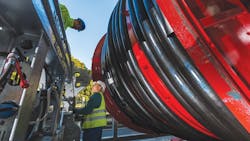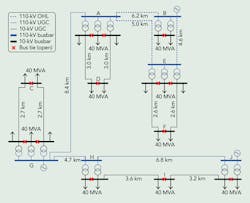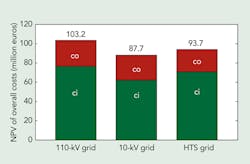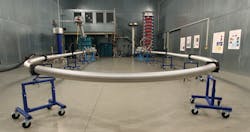The AmpaCity Project
The existing distribution network in Essen, a major city in the German Rhein-Ruhr area, was constructed when a central power supply together with large industry dominated the townscape and infrastructure. Essen’s distribution network then consisted of several 110-kV underground cables supplying 10-kV distribution substations. However, because of economic and structural changes in the Ruhr area, coupled with the expiring service life of some of the existing assets, larger investments will be needed for the refurbishment and modernization of this distribution network in the coming years.
Faced with these investment decisions, the local distribution network operator, RWE Deutschland AG, sought to explore all of the potential options to identify the best possible solution for the medium- and long-term distribution network refurbishment and reinforcement. As a first step, RWE, the Karlsruhe Institute of Technology (KIT), the University of Hannover and cable manufacturer Nexans conducted a study to investigate the technical feasibility and requirements for an economically justified application of integrating a high-temperature superconductor (HTS) system into the distribution network.
HTS cable systems have the potential to revolutionize the design and load-transfer capacity of the distribution network because they carry five times the current of a conventional cable system with the same outer dimensions. For this reason, an HTS cable system was selected for use within the AmpaCity project in the city center of Essen. The HTS system replaced a conventional high-voltage cable system by connecting the medium-voltage busbars of two substations. AmpaCity serves as a lighthouse project because it is the first time a 1-km (0.62-mile) HTS cable system was installed with an HTS fault current limiter in a distribution network within a city center. Additionally, it is the longest installed HTS cable system in the world.
High-Temperature Superconductors
Superconductors are materials that lose their electrical resistance when cooled to below their so-called critical temperature (Tc). The state of superconductivity also requires being below a certain magnetic field magnitude, and the transport current in the material must not exceed a critical current density. Superconductors have been well known for more than 100 years, but it was in 1986 the present class of high-temperature superconductors was discovered. In contrast to previously known superconducting metals and alloys, the HTS materials of today are ceramic substances.
Because of the higher critical temperature for these materials, the effort needed for cooling is strongly reduced. In 1987, the first superconductor, yttrium barium copper oxide (YBCO; Tc = ‑181°C [-294°F]), with a critical temperature above ‑196°C (-321°F) was discovered. This was considered a breakthrough as that level of cooling could be readily provided by available liquid nitrogen technology. Since then, scientists and engineers have worked on developing flexible conductors made from these novel materials that are suitable for energy technology applications.
Today, superconductor cables can carry a multiple of the current that a conventional cable of the same cross-section can carry, even allowing for the cryogenic envelope (thermal insulation) of the HTS cable. Therefore, the application of HTS cables can provide an economical alternative for large power connections provided the following are met:
- Relatively high currents have to be transported over relatively short distances.
- Medium-voltage HTS cables are employed instead of conventional high-voltage cables; as a result, a simpler network structure and other secondary benefits are achieved.
- The cost of HTS wires and cooling systems decreases.
Forecast of Future HTS Costs
As a result of the rapid advancements in HTS material development, the cost of HTS wires is expected to drop considerably within the next 10 years. This will result from the scaling effects because of higher demand and production rates, and the increasing current-carrying capacity of the HTS material. The higher the superconductor’s current density, the less superconducting wire is needed to build electrical power devices, an effect that also will contribute to the decrease in cost. Despite the higher investment costs for superconductor cable systems, the implementation can be recommended because HTS cables have several advantages over conventional cables:
- Owing to the quasi zero resistance, large currents can be transported at the medium-voltage level so intracity high-voltage equipment as well as high-voltage transformers become dispensable.
- The reduction in the number of high- and medium-voltage transformers required effectively reduces land requirements in high-value city center regions.
- The omission of conventional cable systems and switchgear reduces the distribution network losses.
- The HTS medium-voltage concentric cable systems reduce the width of the right-of-way and cable installation costs significantly.
- A characteristic of their design is that HTS cables do not produce external electromagnetic fields.
- HTS cables do not emit heat; hence, there is no drying out of soil and no reduction in the transmission capacity when crossing other cables and vice versa.
Economic Comparisons
The economic comparison of different network configurations was based on a 110-kV network design to supply the forecasted maximum demand for Essen’s city center in 2020. RWE compared the existing 110-kV network design concept with an innovative grid concept based on a 10-kV infrastructure, which exhibits the same redundancy and is rated for the same load requirements. The network design concept with 10-kV infrastructure would require fewer 110-kV cable circuits and substations. This network could be reinforced with superconducting as well as conventional 10-kV cable systems.
If RWE were to change the system design concept from a 110-kV to a 10-kV network, four 110-kV substations, five 110/10-kV transformers with associated switchgear and 12 km (7.5 miles) of 110-kV cable system would become obsolete. In contrast, for the 10-kV network design concept, three 10-kV bus ties and 23.4 km (14.5 miles) of 10-kV cable circuits with the associated 10-kV switchgear for eight connections would be required.
Future HTS Systems
The feasibility studies, including the cost of conventional cable and HTS cable, were evaluated based on the expected future cost structure. Three different network options were compared, taking into account only those sections of the network requiring change. The first option was a 110-kV network employing conventional cable systems, the second option was a 10-kV network with conventional cable systems, and the third option was a 10-kV network with HTS cable systems. The assumptions used in the economic comparison were a lifetime of 40 years, an interest rate of 6.5% for determining the net present value and a 2% per annum increase in operating costs.
The overall results showed the net present value of the option with superconducting cables was below the option employing conventional 110-kV cable systems. The design option based on conventional 10-kV cable systems proved to be the most economical. However, after due consideration of the cost of electrical losses, which would be higher with this option than the HTS cable option, and the large space requirement for the installation that would prohibit its use in densely populated areas, the HTS cable option was deemed the preferred option based on life-cycle costs.
The installation of superconducting cable systems might be the best option based on technical and economic considerations. In large cities, like Essen, one of the most important aspects is the space requirements for the installation. The transmission of 40 MVA between two substations can be realized with one conventional high-voltage cable system (three single-phase cables), a superconducting cable system (one three-phase cable) or five conventional medium-voltage cable systems (15 single-phase cables). Each of these options has different cable installation and space requirements
HTS Cable System Implementation
The space beneath the streets of many city centers is quite restricted by the multiplicity of utility services, therefore, more attention has to be given to the space required for cable installations. This was a primary reason RWE decided to install a superconducting cable system in Essen’s city center. Installation took place in October 2013. The 1-km-long 10-kV HTS system in the city center interconnects two existing substations. Because of the innovative nature of the AmpaCity project, it is funded by the Energy Research unit of the German Federal Ministry of Economics and Technology (BMWi). The total project cost 13.5 million euros (US$17.5 million), including funding of approximately 6 million euros ($7.79 million).
Main System Components
The 10-kV HTS system, manufactured by Nexans with a transmission capacity of 40 MVA, comprises a three-phase superconducting cable with concentrically arranged phase conductors and a superconducting fault current limiter. For the cable, KIT characterized suitable HTS materials, performed simulation studies and supported the project scientifically. Further components of the HTS system are as follows:
- Two terminations in which the transition between superconductor and conventional conductor materials as well as the thermal transition are realized
- One joint installed approximately in the middle of the route to connect two cable sections
- A cooling system that supplies liquid nitrogen for the cooling of the cable and fault current limiter.
As a result of reducing space requirements, the concentric arrangement of the three-phase conductors in the superconducting cable eliminates electromagnetic field emissions during normal operation. The outer diameter of the cable including the cryostat (thermal insulation) and a polyethylene sheath is approximately 150 mm (6 inches).
The terminations serve as the transition connection between the superconducting cable and the conventional cable, also providing the cooling system connection. Liquid nitrogen is used to cool the cable to the operating temperature. Therefore, in the terminations, a compensation of approximately 200°K (-99°F) temperature difference is achieved, and it is this thermal transition that determines the size of the termination.
Lab Tests
While the superconducting fault current limiter is manufactured based on a proven design, all components of the AmpaCity cable system — cables, joints and terminations — were new developments and, therefore, needed required testing in the laboratory. The first pre-prototype tests were completed successfully in November 2012.
The main test objectives were the verification of the cable design with respect to high-voltage and mechanical requirements, as well as the verification of the termination design. For the high-voltage tests, a 30-m (98-ft) length of the pre-prototype cable with two prototype terminations was set up in a loop in Nexans Hannover laboratory. The design of the pre-prototype cable was the same as the AmpaCity cable only, for cost reasons, most of the superconducting tapes were replaced by copper tapes with the same dimensions. On the pre-prototype setup, high-voltage tests were carried out including partial-discharge measurements, lightning impulse voltage tests as well as alternating current voltage-withstand tests.
In addition, mechanical bending tests were performed with a 20-m (66-ft) section of the pre-prototype cable. After bending the cable multiple times, 2-m (7-ft) samples were cut. Each sample was dissected and the critical current of the recovered superconducting tapes was measured. All the superconducting tapes were measured and no degradation of critical current was observed.
The successfully completed tests on the pre-prototype cable were followed by a type test in spring 2013. The type test setup included two sections of an entirely superconducting prototype cable, one joint and two terminations. Type tests were finished successfully in March 2013, and production of the final 1-km-long cable started. The installation of this cable in the city center of Essen took place in October 2013, including the assembly of terminations and joint. Nexans was responsible for installing and commissioning the HTS system and fault current limiter. In the winter 2013-2014, the cryogenic system serving the HTS system will have its behavior tested for the first time under load conditions.
Flagship Project
The HTS network is subject to field testing for a period of at least two years. This testing regime includes the fault current limiter, and cable and cooling system. The experience gained during this field-test period will be of great importance, both for RWE in terms of future expansion and refurbishing of urban power networks, as well as for the superconductor industry.
The success of this project can contribute significantly to the acceptance of the superconductor technology by potential users, and through an increased demand, it also can lead to increased production with associated cost reduction of superconducting tapes for power industry applications.
Acknowledgement
The authors wish to acknowledge the technical support and advice given by Mark Stemmle and Achim Hobl, both
experts in the field of superconductivity at Nexans.
Frank Merschel ([email protected]), following his studies at the Leibniz Universität Hannover and graduation with a thesis on electrical insulation materials, worked in different occupations and locations in the German utility RWE. Presently, he is coordinating research and development projects in the distribution grids of the RWE group. In addition, Merschel is working in the field of cable standardization and is a lecturer in cable technology for energy and communication cables at the Leibniz Universität Hannover.
Mathias Noe ([email protected]) holds a master’s degree in power engineering and a Ph.D. from the Leibniz Universität Hannover. After a postdoctoral position at the Ecole Polytechnic Federale de Lausanne in Switzerland, he joined Forschungszentrum Karlsruhe in 1998 and became a group leader for high-temperature superconducting power devices at the Institute for Technical Physics. Noe is the director of the Institute for Technical Physics at the Forschungszentrum Karlsruhe and a professor for technical applications of high-temperature superconductivity.
Companies mentioned:
BMWi | www.bmwi.de
Karlsruhe Institute of Technology | www.kit.edu
Nexans | www.nexans.us
University of Hannover | www.uni-hannover.de





